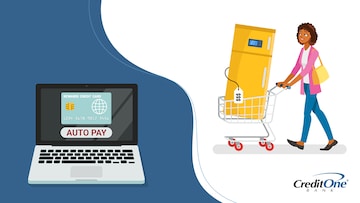
Guide to Managing Multiple Credit Cards for Maximum Rewards
November 30, 2023
Having multiple credit cards lets you maximize rewards, but it’s important to be strategic in your card use so you can maintain good credit health.

Credit cards are a great tool if you use them the right way, but rewards are probably their coolest feature. After all, you can get cash back or points just for buying what you would normally buy? Ka-ching!
The best strategy for taking advantage of these rewards is to use each card for the categories that earn the highest rewards, and then pay off each card every month.
Another decision to make is which type of rewards credit card could be right for you. Because not every rewards program is the same, and one or the other could better suit your lifestyle and your needs.
There are three basic types of credit card rewards:
- Cash back
- Points
- Miles
Cash back rewards usually give you a payment or statement credit equal to a certain percentage of eligible purchases. Often you can earn higher cash back rewards for specific categories, like gas, groceries, dining, travel, entertainment, cable TV, or streaming services.
Rewards points are earned in a similar way, but you usually have a choice of when and how you want to redeem your credit card rewards. Sometimes you can turn your points into cash back, but you can also typically trade them in for discounts, gift cards, and other perks.
Mileage rewards, or simply “miles,” are similar to points. But they’re usually specifically focused on travel and geared to frequent flyers. Some mileage rewards are generic and can be used for various travel services, whereas airline miles are often tied to a specific airline or their partners.
To figure out which credit card is best for you, consider what you usually buy and what kind of rewards you could make use of. Also keep in mind that each rewards program has its own terms and conditions, such as what kind of purchase earns which level of reward and how long you have to redeem them once they’re earned.
Benefits of Having Multiple Credit Cards
Most adults living in the US have at least one credit card, and the average number is consistently between three and four. Credit cards give you the power to spend, which could be good or bad … you know what Spider-Man was told about great power bringing great responsibility. The same applies here.
With credit cards, that responsibility means only charging what you can afford and paying your bills on time, every time. So as long as you wield those plastic weapons responsibly, there could be benefits to owning multiple cards.
Higher credit score
Getting a higher credit score from having multiple cards isn’t guaranteed, and trying to raise your score this way could be a slippery slope (you’ll see why in the next section).
But … with lots of disclaimers … having more credit cards gives you more available credit, which can lower your credit utilization ratio (CUR) and therefore raise your credit score. If (big if) you don’t max out those credit cards. Yeah, that’s another part of being responsible with your credit.
Rewards potential
And now for the fun part. Having multiple credit cards — as long as they’re rewards cards — gives you access to a wider range of rewards options than just having one. For example, one card might reward gas and grocery purchases while another rewards flights and hotels, and a third rewards entertainment categories.
That means you can tailor each card to the appropriate spending categories, and only purchase what gets the highest rewards with each one.
Just be sure to compare credit card offerings before choosing which one to apply for, because each application is a hard inquiry on your credit report.
Dangers of Mismanaging Multiple Credit Cards
It’s definitely possible to have too many credit cards. If you gravitate toward instant gratification, it’s easy to max them out, which causes all kinds of problems. If you’re going to carry multiple credit cards, be careful not to fall into the common trap of mismanaging your spending.
Debt accumulation
If you spend too much on your cards, you immediately reduce your available credit, but it gets worse from there. If you can’t pay it off right away, you’ll start to accumulate debt. The longer you keep a balance going, the more you’ll pay in monthly interest charges.
It’s worth mentioning again: if you’re going to use credit cards, it’s important to cultivate the habit of being responsible with them. You know, the whole Spider-Man thing.
Lower credit score
Carrying that debt obviously gives you less available credit, but more importantly, that means a higher CUR. It might not seem like a big deal — isn’t credit there to use it? But no, it’s not. Using all your available credit and raising your ratio can negatively impact your credit score.
Strategies for Maximizing Rewards on Multiple Credit Cards
Now that we’ve got all the warnings out of the way, let’s look deeper at one of the benefits of having multiple credit cards. Namely, it lets you strategize your spending to maximize your credit card rewards.
There are a few steps you can take to ensure you’re making the most of the rewards programs from different credit cards. When you can boost your payback from each purchase, you’re in a position to maximize your returns in the process.
Using the right card for the right purchase
The first step is choosing the right card for the right purchase, even if that’s several different cards on the same day.
Let’s say you have one card that gives you 5% cash back rewards on gas purchases, and another that gives 2%. When you fill up your tank, you should choose the 5% card for the biggest returns. But maybe the one that offers 2% on gas also gives 2% on dining purchases, while the one with the higher gas rewards only offers 1% for eating out. So you use the 2% card to pay for your dinner date.
And maybe you have a third card that doesn’t give extra points on those categories but does give you 5% worth of purchases in points if you book a hotel or car rental. So that’s the card you would use for your travel expenses.
Determine what the premium spending categories are for each card, whether that’s groceries, dining, travel, utility bills or entertainment purchases. And use that specific card every time you buy those things.
You also might have a card that gives you a flat reward level on all purchases, but has bonus offers from participating merchants, like More Cash Back Rewards or Amex Offers. In that case, it’s definitely worth it to monitor and activate the bonus rewards whenever you can.
Timing your credit card applications
Some credit cards come with sign-up bonuses that give you extra rewards if you fulfill the criteria. Usually that means spending a certain amount within a specific time frame, such as $1,000 within the first six months. Keep track of these welcome bonuses so you don’t miss the purchase deadline.
If you time your new card applications to correspond with special bonus offerings, you can maximize returns right off the bat. But instead of just applying for an attractive card, see if you’re pre-qualified first, which doesn’t affect your credit score. Same goes if you received a pre-approval letter in the mail.
Tips for Efficiently Managing Multiple Credit Cards
Now that we’ve talked about the benefits of using multiple credit cards, there are some measures you should take so it doesn’t get overwhelming or out of control.
Keeping track of due dates and balances
One of the most important things you can do for your credit score is to pay your bills on time. That action also helps you avoid late fees, and even interest charges if you pay the full balance.
The traditional approach was to mark all your due dates on a calendar, but leveraging technology is a great option here. Download your card provider’s app and set up AutoPay so you never miss a payment, or use a third-party app that consolidates spending, tracks multiple balances, and alerts you to issues and due dates.
Regularly reviewing credit card statements
Of course, multiple cards mean multiple statements, and it’s important to review your credit card statements regularly. The first thing you need to understand is how much you’re paying in interest and fees so you can adjust accordingly. These will be listed out in a separate set of entries.
Next, look for any potential errors or fraudulent transactions. If you notice a subscription charge that you didn’t know you agreed to, or a duplicate entry for something you bought, contact the merchant directly to ask for a cancelation or refund.
If the merchant won’t cooperate or the charge is fraudulent, contact your creditor and dispute it. They will likely cancel your card and replace it with a new one, and you might need to submit a report. So make sure it’s actually an error and not just a forgotten purchase.
Navigating Credit Card Reward Programs
Earning rewards is just the beginning. In many cases, you need to take action if you want to redeem those rewards, whether for a statement credit, gift card or merchandise. Sometimes your rewards will even expire if you don’t use them within a certain time frame. So make sure you understand the terms of the program and keep an eye on your rewards to avoid missing out.
Navigating the various rewards programs might sound intimidating, but you usually receive a guide with your card that explains how it works. You might even be able to access the terms and processes through your card provider’s app or website. Keeping all your cards’ reward terms in one place makes it easier to track everything, whether you prefer to keep the paper copies in a folder, list them in an online document, or bookmark the web pages on your computer.
Making Multiple Credit Cards Work for You
It might sound fun to have a whole selection of credit cards in your pocket so you can whip them out at any time and say, “Pick a card, any card.” But there are two things wrong with this picture. First, managing multiple cards responsibly takes a bit of work. And second, you should always be the one picking the card.
If you want to maximize your rewards, remember to always use the right card for every purchase. Never max out your cards — or worse, go over your limit, which brings its own slew of additional fees. And make all your payments on time, for the full balances if at all possible.
Following the strategies discussed here is the best way to benefit from having multiple cards. If you want to add some robust rewards options to your wallet, browse through the range of credit card offerings from Credit One Bank. They all offer rewards, whether points or cash back. And they all give you the opportunity to pre-qualify before making a decision to apply.


